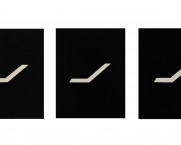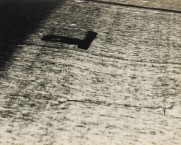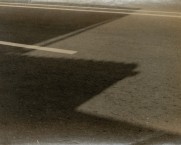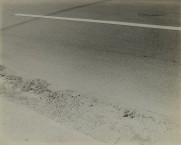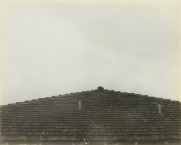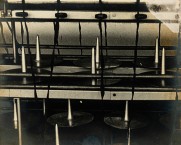C&L Shows
Autobiography of a Line
Nasreen Mohamedi
2022
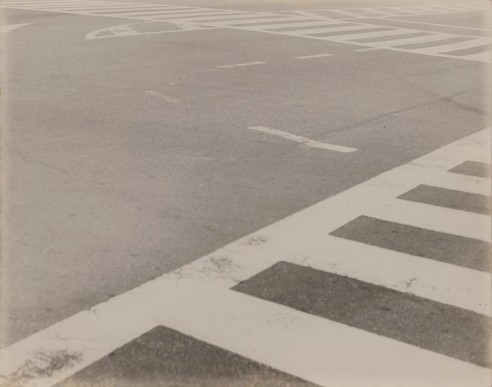
Overview
Line as human
means to express
the relation between
points, something
that is entirely abstract
in the sense: of not
existing materially
in nature.
Line as medium
indicates materially
the relation between
points in space,
expressing visually
human descriptive thought.
Line as object to play with.
Gego: Sabidura 4 1
A line inhabits its own space. And as such, it is not a component in a work but instead is a work by itself. Similarly, Nasreen Mohamedi (1937 – 1990) does not use line to represent an image; line is the image. Developing aphoristic meditations in her practice, she unfolds points of departure that reflect a process leading her to master the space that reason dominates or tries to. The strength or purpose of the line is enhanced by being doubled, tripled, and quadrupled or even cut out. It communicates and emphasizes the fluidity of life in opposition to any attempt to a fixed reading and offers a reflection on the many simultaneities in our contemporary world, its interrelations, and superimpositions. The artist’s lines are that existential aspect of life, seen as tangible orientations within a space that is at once closed and open, ordered, and chaotic. It is with great sensitivity and painstaking precision, but also deliberately leaving scope for error, that she scores her art – inscribing it as it were.
Whether or not Mohamedi saw herself as a photographer one does not know, however her practice can be linked by what at times might seem like an extra photographic impulse – in a world of her own making: whether amidst the urban environment of built spaces and road signs; of environmental phenomenon like patterns on the beach; or, else, of unusual shapes like using refractors for the graphic contrast of light and dark. All lending towards a minimalist aesthetic by constructing or documenting abstracted photographic geometries and trajectories in space. The use of lines in these photographs vary in thickness, scale, length, and direction emphasizing the notion of ‘line’ that retains its strength and independence regardless of its specific location or form. Is there then an attempt to represent the relationship between them? Infuse in them life’s energy and simple matter, merging both the perceptual and conceptual knowledge in ever changing forms? Does Mohamedi, through these photographs of lived, used, and unused spaces – of waiting, living, walking, and crossing – capture these anonymous signs of time? Yet does she also allow them to occupy a relatively silent space that attests to the artist’s journey from traces of her own environment through to abstraction? For instance, the paper cut outs placed at slightly variable angles to one another produces a dynamic visual relationship between the lines, creating a sense of movement, experimentation, and spontaneity.
The artist makes visible how she understands this complex relationship between line, space, place, and the poetics of discovery that are within its frame, alluding perhaps to Walter Benjamin’s perception of a drawing where the mobility agent is a point, shifting its position forward. In his essay ‘Painting, or Signs and Marks’ (1917), Benjamin expresses a related idea when he observes that drawing exists at another level within the human psyche – it is a locus for signs by which we map the physical world, but it is itself the pre-eminent sign of being 2. Mohamedi’s black and white photographs, prints and cut outs emphasize in abstract form the relationship between line and thought or idea, exploring through abstraction the conflation of inside and outside, micro and macro, thought and action where it is not a window to the world, ‘but a device for understanding her place within the universe’.
Does imagination fill a space with spirit and meaning? And reciprocally, does that space then evoke feeling, memory and thought – giving it form? I believe it does. Gaston Bachelard’s ‘The Poetics of Space’ (1958), is a phenomenological interrogation into the meaning of spaces that manifest elements of poetry – with emphasis on locations and places of intimacy and memory. Attempting to trace the reception of the poetic image in the subjective consciousness of Nasreen Mohamedi’s photographs, it demands an openness and a focus on the poetic image within images that are a direct product of a consciousness, as experienced in the first-person and in one’s imagination. For Bachelard, imagination is a means to experience a space. Our experiences, our memories, our speculations, our imaginations are always layered atop a space, because we bring these spaces with us: we inhabit the space. In the same way that Mohammedi inhabits her space, Bachelard’s spaces are not static arrangements of surfaces or given physical dimensions – they are a site for contingent relations, a dynamic document of human life, within and upon which multiple layers of activity, affect, and information, operating all at once. Arousing different sensations and yet bringing up a unitary, intimate experience of living. It is within these experiential qualities that one can find the poetry in Mohamedi’s work. A door opened is a world revealed; weaving spindles are places of secrets, and with every habitual action she opens endless dimensions of her existence. Every work is a form of drawing. The associative power of the various forms establishes a tie, a shared life, between the works. The imagined nature of a memory provides for a prototype of remembered personal myth. Her works stands at the limit of countless abstraction without jeopardizing the subjective elements of emotion, communication, and imagination.
To conclude, drawing offers us the most extraordinary range of possibilities: it is a map of time recording the actions of the maker. Lines always suggests a continuation ad infinitum and thus connect us with infinity and eternity – a direct link with thought and with an idea itself. Its very nature is unstable, balanced equally between pure abstraction and representation; its virtue is its fluidity. A line can be highly controlled and delicate, an act of homage, redolent of personal memory, history, or desire, or it can be automatic, responding to irrational elements or chance encounters of materials, moving again from being an instrument of the divine to something outside of the human. Nasreen Mohamedi engineers infinity, a state where hierarchies, contingencies, and gravity dissolve, where everything connects, and you can see the connections, both in space and in spirit.
~ Sasha Altaf
Nasreen Mohamedi (1937 – 1990)
Mohamedi was born in Karachi, raised in Bombay and completed her studies in London in Paris. The artist began teaching at MSU, Baroda in 1972. Whilst primarily remembered today for her works on paper, there has been increasing scholarly interest in her photographic work. Since Mohamedi never exhibited these works in her lifetime, exhibitions of her photography have been very rare, and ‘Autobiography of a Line’ marks a first in Indian exhibition history.
Sasha Altaf
Sasha Altaf is an independent curator and was an adjunct professor at the Department of Art and Art History, University of Miami, Florida. She has written and lectured on contemporary Indian art, especially on feminist practices, new media and its contexts. Author of Erotic Autonomy as a Politics of Feminism”, 2010 she completed her BA in Art History at the Maharaj Sayajirao University in Baroda, India and MA in Advanced Studies in Feminism and Visual Art at the University of Leeds, UK and MA in Art History at the University of Miami, USA in 2006 and 1999 respectively.
[1] Zegher, de Catherine. Catalogue Essay: ‘Freeing the Line’. Marian Goodman Gallery, New York, 2006.
[2] Benjamin,Walter. Selected Writings, Volume I, Cambridge, Massachusetts: Harvard University Press, 1996, pg. 83.
A Video Walkthrough by Mort Chatterjee



